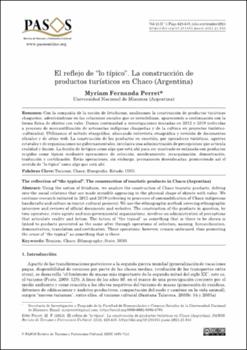El reflejo de “lo típico”. La construcción de productos turísticos en Chaco (Argentina)
Autor
Perret, Myriam FernandaFecha
2023Resumen
Con la compañía de la noción de fetichismo, analizamos la construcción de productos turísticos
chaqueños, adentrándonos en las relaciones sociales que se invisibilizan, apareciendo a continuación con la
forma física de objetos con valor. Damos continuidad a investigaciones iniciadas en 2012 y 2019 (referidas
a procesos de mercantilización de artesanías indígenas chaqueñas y de la cultura en proyectos turístico‐
‐culturales). Utilizamos el método etnográfico, abarcando entrevista etnográfica y revisión de documentos
oficiales y de sitios web. La construcción de los productos en cuestión, por operadores turísticos, agentes
estatales y de organizaciones no gubernamentales, involucra una administración de percepciones que articula
realidad y ficción. La ficción de lo típico como algo que está ahí para ser mostrado es enlazada con productos
erigidos como típicos mediante operaciones de selección, nombramiento, jerarquización, demostración,
traducción y certificación. Estás operaciones, sin embargo, permanecen desenfocadas, promoviendo así el
sentido de “lo típico” como algo que está ahí. Using the notion of fetishism, we analyse the construction of Chaco touristic products, delving
into the social relations that are made invisible appearing in the physical shape of objects with value. We
continue research initiated in 2012 and 2019 (referring to processes of commodification of Chaco indigenous
handicrafts and culture in tourist‐cultural projects). We use the ethnographic method, covering ethnographic
interview and reviews of official documents and websites. The construction of the products in question, by
tour operators, state agents and non‐governmental organizations, involves an administration of perceptions
that articulate reality and fiction. The fiction of “the typical” as something that is there to be shown is
linked to products presented as the same after through operations of selection, naming, hierarchisation,
demonstration, translation and certification. These operations, however, remain unfocused, thus promoting
the sense of “the typical” as something that is there.





